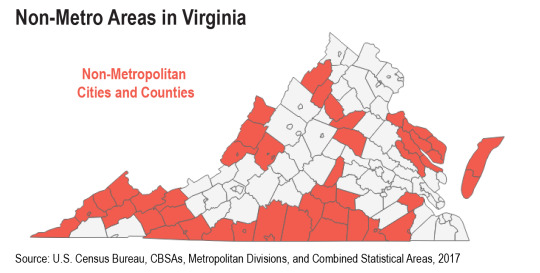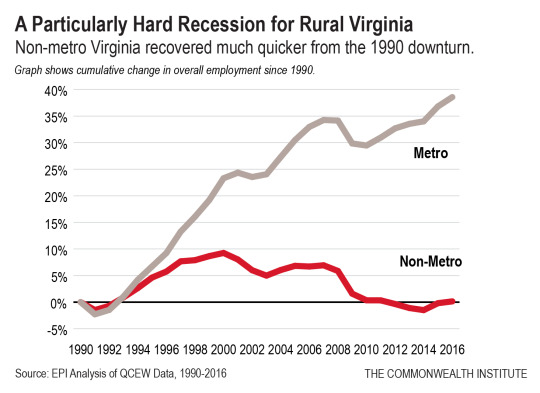August 8, 2018
The Rural-Urban Divide is Visible in Virginia’s Recovery
Working people in every part of Virginia took a hit during the Great Recession. While the economy is improving overall since then, the benefits of recovery have not been evenly distributed. Generally speaking, the commonwealth has more jobs, a lower unemployment rate, and higher wages than it did before the recession. But Virginia’s new jobs are not all in the same places or available to the same people that they were 10 years ago. The shifting economic landscape of a growing state has painted a strikingly different post-recession picture in urban and suburban areas than for rural areas. Thankfully, lawmakers have some tools to bridge that divide.
The terms “rural” and “urban” mean different things to different people, and many parts of Virginia may express characteristics of both. One method to distinguish between the two is to look at “metro” and “non-metro” areas as defined by the U.S. Office of Management and Budget (OMB). OMB uses the economic and social activity around densely populated urban cores to draw a “Metropolitan Statistical Area.” That includes most larger cities and their surrounding suburbs. All areas not included in a Metropolitan Statistical Area can be termed “non-metro,” and can be thought of as rural or small-town communities. Using this distinction, it is clear that job markets have not recovered evenly across all parts of the state since the Great Recession.

(For a live map with locality information, click here.)
Jobs disappeared all over Virginia during the economic decline of 2007-2009, with total employment falling at a steeper rate in non-metro areas. The total number of filled jobs began to increase after 2010 in metro areas, but it continued to decline in non-metro areas through 2014, where it has only recently begun to reverse trend. As a result, in 2016, there were 3.2 percent more occupied jobs in metro areas than in 2007. But in non-metro areas, there were 6.3 percent fewer filled jobs than before the recession.

The total wages paid to all workers in non-metro areas have also climbed at a much slower rate – 11 percent – than total wages in metro areas which have increased 22 percent since 2007.

Virginia’s non-metro areas seem to have had more difficulty rebounding from the most recent recession than from previous recessions. In 1990, like 2007, the economic downturn caused overall employment to drop in both metro and non-metro areas. But overall employment in non-metro areas recovered from that dip within just a few years and continued to increase through 2000. Since then, job markets in these areas overall have stagnated or shrunk. In 2016, there were more than 900,000 more jobs filled in metro areas than in 1990. Over the same time period, non-metro employment increased by 501 jobs – virtually no job growth.

There are many economic factors driving disparities between metro and non-metro areas in Virginia and across the U.S., and these gaps didn’t begin in 2007 – they are part of larger trends in urbanization and the dwindling coal industry in Virginia. They are also likely the result of resource extraction industries, such as mining and timbering, becoming more capital-intensive and relying less on labor. These trends cannot be simply reversed, but state lawmakers have some specific options on the table that could offer an economic development boost to rural Virginia.
They’ve already taken one step to boost rural areas by expanding Medicaid. Hospitals are both literal and economic lifelines in rural areas, and closures in Lee and Patrick Counties in recent years placed serious stress on rural communities. Having more insured patients at hospitals means more money for hospitals, and that could improve the viability of health care providers in struggling areas. This has a potential twofold economic benefit: hospitals are large employers in rural areas, and more people with coverage means healthier people who are able to find and hold on to available jobs.
For rural areas to see the full economic benefit of Medicaid expansion, the state must refrain from putting additional barriers between people and health insurance. Virginia is currently designing a proposal that will take Medicaid coverage away from many people who aren’t working a minimum number of hours or engaged in work-related activities. While it may seem that this could boost lagging labor force participation rates in non-metro Virginia, research has shown that work requirements typically fail to boost long-term employment or improve general welfare. In many cases, these proposals have made it harder for individuals to find work. Health coverage is a work support in and of itself, and ensuring that more people are enrolled in the Medicaid program will bolster many communities.
Another opportunity for economic stimulus is a stronger state Earned Income Tax Credit (EITC). Many areas of the state with the highest shares of families receiving the EITC are in non-metro localities, but a non-refundable credit means they are missing out on the full value. Making Virginia’s EITC refundable would put more money directly into many working families’ pockets each year. This is money that families can spend in their communities, strengthening their local economies. And research has shown that the federal EITC, which is fully refundable, is associated with increasing children’s academic performance, lifetime earnings, and educational attainment. Both the short- and long-term benefits of a refundable EITC make this a smart investment.
And for rural communities that cannot afford to use local resources to finance crucial infrastructure improvements that attract investment, state investment in roads, bridges, and broadband (for high-speed internet access) can directly create jobs while making the area more attractive to private investment.
These policy solutions could help low- to moderate-income communities and individuals no matter where they live, particularly rural communities that have seen too many jobs disappear in the past decade. However, since no two rural areas in Virginia are exactly alike, these statewide solutions will need to be paired with “place-based” solutions that help grow and diversify economies according to the needs of specific communities. Asking rural Virginians to move to jobs isn’t a solution. We can and should continue to make smart, targeted investments so that everyone, in every corner of the state, has every opportunity to reach their full potential.
Category:
Economic Opportunity
